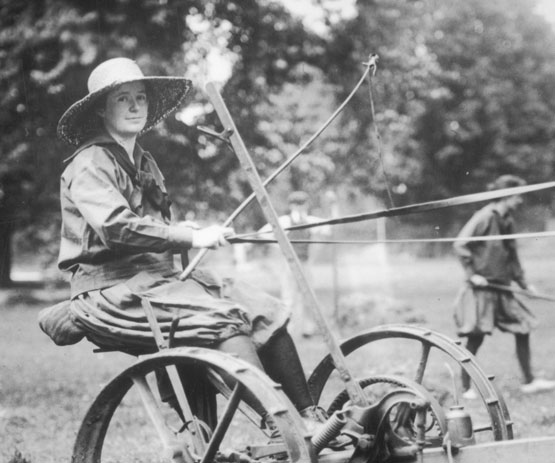The Farmerettes
Working the Farm, Filling a Gap

From the very beginning of the college—when a vegetable garden grew to the west of Raymond Avenue, and cattle grazed to the east—Vassar has had a farm. And for just as long, the college has counted farmers among its graduates. (The Los Angeles Times noted five farmers among the class of 1893.) But with World War I, a new breed of farmer took shape on campus: the Farmerette.
With many men away at war, farms—and the nation’s food supply—were left understaffed. Women mobilized to fill the resulting gap. (“Before Rosie the Riveter,” Smithsonian magazine declared in a 2009 article, “Farmerettes went to work.”) Top women’s colleges were the front lines of that mobilization (along with gardening clubs, suffrage societies, civic groups, and the YWCA). They came together under the auspices of the Woman’s Land Army of America, modeled after a similar organization in Great Britain. Ultimately, the U.S. effort involved nearly 20,000 women.
At Vassar, the Farmerettes were also known as the Vassar Farm Unit. The first participants, 12 young women, worked during the summer of 1917. According to the Vassar Encyclopedia, they put in 45-hour work weeks, earning 17.5 cents per hour, doing “every kind of work that the men tried, with the exception of cleaning the stables.”
As wartime icons, those intrepid femme farmers were even invited to serve as a “live exhibit” at the first Eastern States Exposition, a 10-state agricultural fair held in September 1917. Five girls were excused from class for 10 days to demonstrate their farming prowess for an estimated 138,000 visitors.
The 1918 edition of the Vassarion described a typical day in the life of a Farmerette. The young women woke at 4:30 a.m. and put in two hours of work on the farm before breakfast, which was followed by four more hours of work in the fields. Later in the afternoon, they’d put in another two to four hours of work.
They certainly had plenty to take care of. The 1918–1919 Vassar College Catalog noted that the farm at that time included “a model dairy and poultry farm, greenhouses, stables, storage barns and farmhouses…” The women plowed (using both a tractor and a two-horse plow), planted, weeded, raked, hoed rows, chopped wood, pitched hay, built fences, and milked cows.
Vassar women again took up the cause during World War I and II. The Farmerettes’ contribution to Vassar’s—and the nation’s—long and rich history of agriculture remains a lasting legacy.
